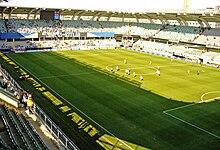Gamla Ullevi
[5] The current attendance record of 18,276 was, however, set about a week later when IFK Göteborg played their first game at Gamla Ullevi against Djurgårdens IF.
[6] But playing in a stadium built almost 100 years ago was not ideal, lacking in service capacity, security, and architecture, the terraces having poles obscuring the view for the audience.
[9] Lars Iwdal said in a newspaper interview that[9] the fact that it was an arena for women's football was Göran's way to get the municipality on the project.The Gothenburg Alliance had their annual meeting on 6 April 2005 and the board decided to support the plan,[10] and on the 9 April the municipal board of Gothenburg arranged a press conference to show the plans.
[11] The new stadium, inspired amongst others by NRGi Park in Aarhus, Aalborg Stadion in Aalborg and mainly Brøndby Stadion in Copenhagen,[12] was to have a capacity of 16,000–18,000 and have open corners; the construction cost was estimated to 180 million SEK for the stadium and a total of 240 million SEK including commercial areas in and around it.
[11][12] The debate in the media following the press conference was mostly about the open corners, if the surface should be grass or artificial turf, and what the name of the stadium should be.
The contractor, Higabgruppen, were reluctant to close the corners of the stadium, claiming a very tight budget and possible growth problems for the grass if that was chosen as surface.
The stadium was also planned to feature two large TV screens and 2,500 m2 of commercial space and a 900 m2 lounge with 18 private boxes.
There are also some concerns that the natural grass may not grow very well since the closed corners and high stand prevent wind and sun to reach the pitch.
Nya Gamla Ullevi will be only the second Swedish top league stadium built since 1966, after Borås Arena that was opened in 2005.
[19] The construction proceeded as planned and work on the foundations was finished by January 2008 according to the project manager Jan-Åke Johansson from Higabgruppen.
He also stated that the stadium's walls and roof would be finished by August 2008—except for the southwestern corner which would remain open a bit longer to allow construction vehicles and cranes to move in and out—and that only interior work would be left to do at that point.
[20] The calculated cost for the stadium had at the same time risen to at least 335 million SEK excluding commercial areas and possibly even more than that when finished in 2009.
The first part of the name, "Ulle-" is the genitive form of Ullr (Swedish: Ull or Uller) which is one of the Æsir—a god in Norse paganism—associated with traits such as skiing, archery, hunting and justice, all connected to sports in one way or another.
The entire decision-making process surrounding the stadium, including its design and cost, was heavily criticised, both by supporters,[38][39] media[12] and the political opposition in Gothenburg.




